Article and photos by Joe Sapia
Note: The yard references are to my house in the section of Monroe between Helmetta and Jamesburg in South Middlesex County. My yard is in a Pine Barrens outlier on the Inner Coastal Plain, the soil is loamy, and my neighborhood is on the boundary of Gardening Zones 6b (cooler) and 7a (warmer). Notes and photographs are for the period covered, unless otherwise noted.
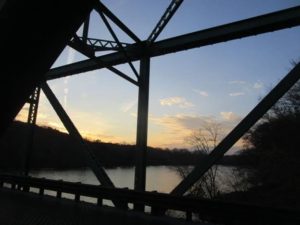
Looking upstream on the Delaware River at dusk from the historic iron bridge connecting Stockton, Hunterdon County, New Jersey, to Centre Bridge, Bucks County, Pennsylvania. The photograph was taken from the New Jersey side, looking toward Pennsylvania. The bridge was built in 1926 and refurbished in 2007. This section of the Delaware River is part of the National and Wild Scenic River System.
DELAWARE RIVER: After the Pine Barrens, the Delaware River is my favorite local ecosystem. I especially love the part of the river north of Trenton. There, an approximately 150-mile stretch of the river, from Washington Crossing at Mercer County, New Jersey, and Bucks County, Pennsylvania, north to Hancock, New York, is part of the National and Wild Scenic River System. Aside from what the System name suggests, eligibility for the System requires the river have protection in place and be free-flowing. At 330 miles, the Delaware River is the longest free-flowing river, meaning it is uninterrupted by a dam, east of the Mississippi River. Next summer, consider tubing the Delaware. Meanwhile, these two books can keep you company, “Natural Lives, Modern Times – People and Places of the Delaware River” by Bruce Stutz and “The Illustrated Delaware River – the History of a Great American River” by Hal Taylor.
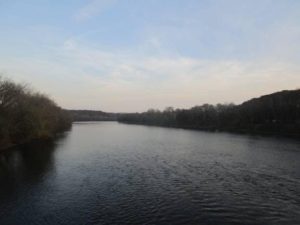
Looking downstream on the Delaware River from the Centre Bridge-Stocton bridge. New Jersey is to the left, Pennsylvania to the right. This section is part of the National and Wild Scenic River System.
HOUSE SPARROWS: I watch many a bird perched in the shrubs outside my living room window at Monroe, Middlesex County. This week, I noticed a small bird of chestnut, black, and gray – a house sparrow, “Passer domesticus.” Beautiful! Alas, it is non-native, a species from Eurasia and North Africa introduced to North America in New York in 1851, according to the National Audubon Society. “Many people regard house sparrows as undesirables in their yards, since they aren’t native and can be a menace to native species,” according to Cornell University’s All About Birds website. “House Sparrows are so closely entwined with people’s lives that you probably will find them around your home even without feeding them.” (A shout out to two New Jersey Audubon Society naturalists for heading me in the proper direction in identifying this bird: Pete Bacinski, retired, and Scott Barnes, active. I am a pretty bad birder, so I appreciate the help.)
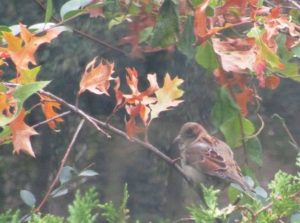
A house sparrow in the front yard of my house in Monroe, Middlesex County.
CANADA GEESE: Speaking of beautiful but pain-in-neck birds, I observed Canada geese in different locales during the week. I have a funny relationship with Canada geese, “Branta canadensis,” finding them to be admirable parents and elegant when personally connecting with them, while in a standoffish way viewing them as pooping, polluting pests. This week, I leaned in a positive direction. (If you get a chance, observe Canada geese as a couple. “They mate for life with very low ‘divorce rates,’ and pairs remain together throughout the year,” according to Cornell University’s All About Birds website. Also, they care for their young as very protective parents. Perhaps a lesson for humans, “Homo sapiens.”)
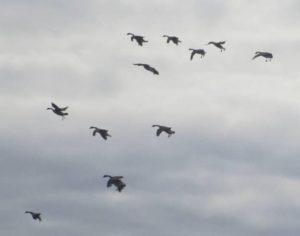
Canada geese landing at a retention pond near Route 33 in Monroe, Middlesex County.
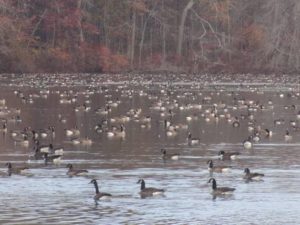
Canada geese dot ETRA Lake in East Windsor, Mercer County.
VOICES FROM AFIELD, No. 1, WILL SIGLE: Fellow Monroe, Middlesex County, resident Will Sigle, a retired science teacher, checked in with some thoughts on farming and wildlife. One of the things Will mentioned was about his yard, “Last year, I had a red-tail (hawk, ‘Buteo jamaicensis’) dining on a daily basis. Amazing how quiet the yard was when he was around.” Ah, yes, when a raptor is around, smaller birds know to beware.
BIRDING NOTES: While in my house in Monroe, Middlesex County, one night this week, I heard a great horned owl, “Bubo virginianus,” hooting. This species is an early breeder, so I am figuring it was either a territorial call or a call for a mate. I went outside to get a better idea where it was calling from, but it had stopped by the time I got outside. Keep your ears open for this resonating baritone. Years ago, one must have landed in a tree near my bedroom in the Monroe farmhouse I was living in at the time and started calling – Man, did I come alive in surprise when I first heard it.

A pumpkin patch at the Fresh Ponds section of South Brunswick, Middlesex County.
DEER RUT: One night, this week, I heard a familiar rustle in the fallen leaves of my neighborhood. I waited and, yes, a doe and her two young walked through a neighbor’s yard and onto my street. Hiding in bushes in my front yard, I watched them for maybe 10 or 15 minutes, only 125 feet or less away. They were jumpy, but they never fled. Finally, I lost sight of them up the street. This week, I saw no bucks, as I had been seeing in recent weeks. So, I suspect the mating season, or rut, of deer, “Odocoileus virginianus,” is at its peak – with bucks and receptive does holed up in secluded spots in the woods.
THE ENIVIROMENTALISM OF DEER HUNTING: “U.S.1” newspaper recently had an interesting article on how deer-hunting is now environmentally in vogue, at least in some circles such as in the Hopewell Valley area on the boundary of Mercer, Somerset, and Hunterdon counties. When this was mentioned here recently, it generated quite a bit of pro-hunting chatter. The recent “U.S.1” article, http://princetoninfo.com/index.php/component/us1more/?Itemid=6&key=11-8cover.
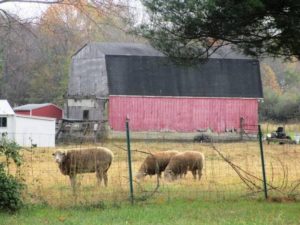
Sheep at a farm in Monroe, Middlesex County.
FIRE IN THE PINES: The state Pinelands Commission is considering fire-break permits in the Pine Barrens area it covers – basically from the Route 528/Cassville section of Jackson, Ocean County, and south. The Pine Barrens are susceptible to wildfire because of their well-drained, sandy soil with dry, dense, and highly flammable vegetation. Fire-breaks can stop fires or at least hopefully slow their threat.
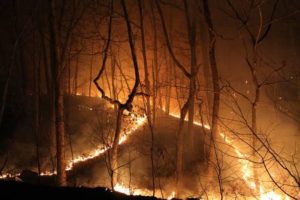
Helmetta’s Joey Slezak took this photograph of a state Forest Fire Service control-burn a few years ago in the Pine Barrens around Helmetta. The Pine Barrens around Helmetta are not part of the state-regulated “Pinelands.” (Photo copyrighted by Joey Slezak).
VOICES FROM AFIELD, NO. 2, VERONICA VAN HOF: Veronica Van Hof, director of the Unexpected Wildlife Refuge a bit south of the Midlands in Buena Vista, Atlantic County, checked in, regarding how spring peeper treefrogs, “Pseudacris crucifer,” normally early spring callers, have been heard in recent weeks: “We heard peepers recently, too! I was surprised but they’re so unmistakable.” Veronica also noted the arrival of winter visitors, bufflehead ducks, “Bucephala albeola,” down from Canada, “Just got our first buffleheads today” — Sunday, November 12 – “a pair lazily dabbling around the pond.”
DAIRY FARMS: In recent years, there has been a resurgence in dairying (at a scaled-down level) and home delivery of dairy products. But in my youth in the 1960s, local commercial dairy farms, along with home delivery, were a way of life – in my case, Forsgate Farms of Monroe, Middlesex County, at my Monroe home and Decker’s Dairy of Hightstown-East Windsor, Mercer County, at my elementary school, St. Mary School in South River, Middlesex County. The Hightstown-East Windsor area also had Conover’s Dairy. Conover’s Dairy, for example, closed in 1972, according to the East Windsor township website. (See https://www.east-windsor.nj.us/conovers-dairy.)

A Conover’s Dairy and Decker’s Dairy display at the Hightstown Diner in Mercer County.
PERRINEVILLE LAKE PARK: New Jersey’s Coastal Plain, as its name suggests, is generally flat. But at Perrineville Lake Park in Millstone and Roosevelt, both in Monmouth County, the land is hilly, thanks to the cuesta geological formation. This hilly formation generally runs from Sandy Hook in Monmouth County to the Philadelphia area, dividing the sandy soil Outer Coastal Plain and the generally dark soil Inner Coastal Plain. The park is about 1,200 acres and includes the lake, formed by the damming of Rocky Brook, woods, and field. More on the park, http://monmouthcountyparks.com/documents/130/PerrinevilleForWeb.pdf and https://www.monmouthcountyparks.com/page.aspx?Id=2550.
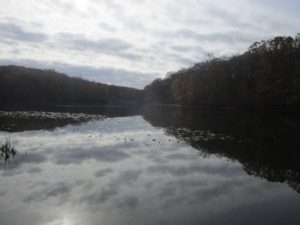
Perrineville Lake in Millstone, Monmouth County.
DELAWARE AND RARITAN CANAL: The Delaware and Raritan Canal’s main shipping channel ran about 30 miles between the areas of New Brunswick, Middlesex County, and Trenton, Mercer County. Another canal, the feeder canal, replenished the main canal with water from the Delaware River. The feeder canal also ran about 30 miles between the areas of Frenchtown, Hunterdon County, and Trenton. The feeder canal later was used for shipping, too. The canal operated for about 100 years from the 1830s to the 1930s. Today, the canal provides easy hiking, bicycling, boating, and fishing along both main and feeder canals. More information, http://www.dandrcanal.com.
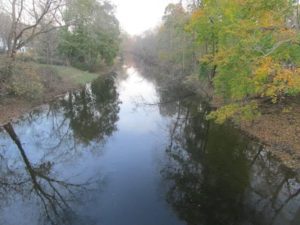
Looking south on the Delaware and Raritan Canal’s feeder at Stockton, Hunterdon County.
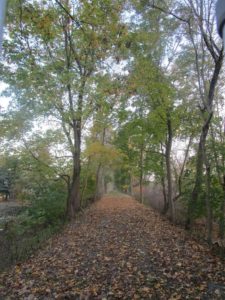
The Delaware and Raritan Canal, here the feeder canal, towpath at Stockton, Hunterdon County.
OCEAN TEMPERATURES: The Atlantic Ocean temperature at Sandy Hook was about 49 degrees over Friday-Saturday, November 17-18.
SUNRISE/SUNSET: For November 19, Sunday, to November 25, Saturday, the sun will rise about 6:50 to 6:55 a.m. and set about 4:35 p.m. For November 26, Sunday, to December 2, Saturday, the sun will rise about 6:55 to 7:05 a.m. and set about 4:30 to 4:35 p.m.
WEATHER: The National Weather Service forecasting station for the area is at http://www.weather.gov/phi/.
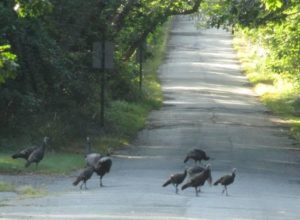
Happy Turkey Day – Thanksgiving, Thursday, November 23. In the photograph, wild turkeys, “Meleagris gallopavo,” cross a road in the Pine Barrens around Helmetta in 2015.
Joe Sapia, 60, is a lifelong resident of Monroe — in South Middlesex County, where his maternal family settled more than 100 years ago. He is a Pine Barrens naturalist and a gardener of organic vegetables and fruit, along with zinnias and roses. He draws inspiration on the Pine Barrens around Helmetta from his mother, Sophie Onda Sapia, who lived her whole life in these Pines, and his Polish-immigrant grandmother, Annie Poznanski Onda. He gardens the same backyard plot as did his Grandma Annie and Italian-American father, Joe Sr. Both are inspirations for his food gardening. Ma inspires his rose gardening. Joe is a semi-retired print journalist of almost 40 years. His work also is at @JosephSapia on Twitter.com, along with Facebook.com on the Jersey Midlands page.
Article and photos by Joe Sapia
Note: The yard references are to my house in the section of Monroe between Helmetta and Jamesburg in South Middlesex County. My yard is in a Pine Barrens outlier on the Inner Coastal Plain, the soil is loamy, and my neighborhood is on the boundary of Gardening Zones 6b (cooler) and 7a (warmer). Notes and photographs are for the period covered, unless otherwise noted.
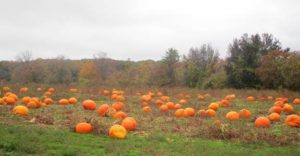
Pumpkins and fall foliage, both taking a last stand for the season, at the Red Wagon Farm Market on Route 33 and Smithburg Road/Route 527-A in Manalapan, Monmouth County.
SNOWBIRDS: I saw the first “snowbirds,” or dark-eyed juncos, “Junco hyemalis,” of the season on Tuesday, November 7, Election Day, around sunrise at St. James Cemetery in Monroe, Middlesex County. The birds are easy to identify by their gray tops and white undersides – “gray skies above, snow below” – and the white edges of their splayed tails as they take off. My rule of thumb is to look for these birds around Halloween, October 31, arriving for the cold weather from as close as the high ground of North Jersey or Pennsylvania and as far away as Canada. Around my yard, I look for these small birds on the ground under the bird-feeder or in bushes. I will see them around my yard to about mid- to late April.
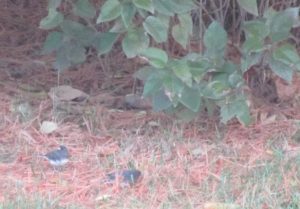
I saw the first “snowbirds,” or dark-eyed juncos, of the season Tuesday, November 7, Election Day, at St. James Cemetery in Monroe, Middlesex County. These birds arrive from the north for the cold-weather season.
VOICES FROM AFIELD, MORE WINTER BIRDS: Diane Larson, a long-time gardening mentor, checked in on the afield side, regarding Beaver Dam Creek in Brick, Ocean County. “Another bird sign of winter – the buffleheads (“Bucephala albeola’’) and mergansers (genus “Mergus”) arrived in Beaver Dam Creek right on schedule – saw them Saturday (November 4) for the first time. We also have otters (“Lutra Canadensis”). They are very elusive, but we’ve seen them and heard them splashing in the water around 8:00 p.m. one night (during) the last week of October. We went outside and tried to see them, but they swam away. All we saw was their wake and heard their grunts.”
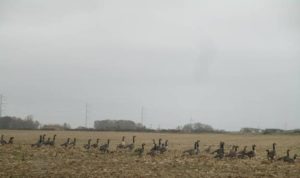
Canada geese, “Branta canadensis,” on the Skeba Farm in the Applegarth section of Monroe, Middlesex County.
BIRDS IN MY YARD: As I was doing yardwork, birds were feasting on corn hearts at my backyard bird-feeder: dark-eyed junco, “Junco hyemalis”; mourning dove, “Zenaida macroura”; tufted titmouse, “Baeolophus bicolor”; and Carolina chickadee, “Poecile carolinensis.”
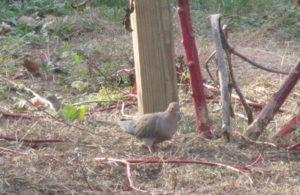
A Mourning Dove at my Backyard Bird-feeder

A Tufted Titmouse at my Backyard Bird-Feeder
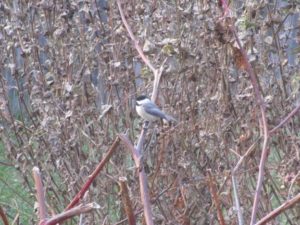
A Chickadee at my Backyard Feeder
GARDEN AND YARD: As I cut the lawn, hopefully for the last time of the year, I smelled wild onions I had mowed down. A bittersweet scent – one pointing back at the year’s peak of vegetable growing, one pointing to a gardening season that lingers. The Jamesburg-to-New Brunswick area of Middlesex County got down to about 20 degrees on the Friday-Saturday, November 10-11, overnight, pretty much bringing an end to the warm weather gardening season. However, I did find a few cherry tomatoes in my garden. (I have a cool weather crop of carrots planted. So, I am hoping for some kind of harvest.) So, this week, I cut the lawn, dumped my last barrel of gardening water, and mowed down the garden, except for the carrots. As for the yard work, I try to get that all done by Thanksgiving.
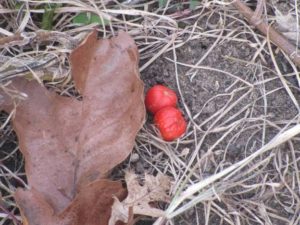
I found these cherry tomatoes in my garden. The top one was in good condition and I popped it into my mouth right in the yard and ate it.
VOICES FROM AFIELD, NO. 2, LINGERING SPRING: Last week, I mentioned I thought I heard the call of a spring peeper treefrog, “Pseudacris crucifer,” at Farrington Lake on the boundary of South Brunswick, East Brunswick, and North Brunswick in Middlesex County. They are normally early spring callers. Jean Montgomerie, an environmental scientist who lives in Freehold and works in the Pine Barrens, said, “Those were spring peepers; I heard them last week too.” Spring, in the form of fall, is playing itself out again, this year.
NIGHT SKY: With the cold spell at the end of the week, I stood in my yard between about 10:30 p.m. and 11:30 p.m. and looked at the night sky. With the temperature at about 23 degrees and very little moisture in the air (with a dewpoint of about 8 degrees), it was one of the clearest night skies I recall, with great views of Auriga (overhead/east); Pleiades, or Seven Sisters (overhead); Orion (southeast); the Great Square of Pegasus (southwest); Cassiopeia (northwest); and the North Star. Take advantage of cold, dry fall and winter overnights. Get a revolving star chart, turn off the outside lights, go outside and acclimate your eyesight to the darkness, and look into the night sky.
THE MOON: The moon is waning from the Full Frost Moon of the November 3-4 overnight. The next full moon is the Long Night Moon on the December 2-3 overnight.
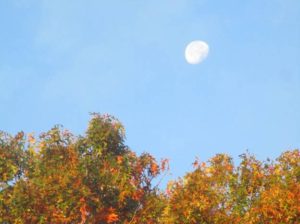
The morning moon, with the changing colors of the fall foliage underneath, at St. James Cemetery in Monroe, Middlesex County. The moon is waning from the Full Frost Moon of the November 3-4 overnight. The next full moon is the Long Night Moon on the December 2-3 overnight.
FALL FOLIAGE: The changing colors of fall foliage are all over the place – some past full color, some peaking, some yet to come. I take the colors as they come, rather than concentrating on a peak.
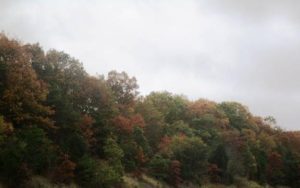
The changing colors of the fall foliage along Interstate 195 in Jackson, Ocean County.
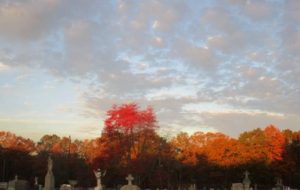
The rising sun’s light hits the top of the trees, lighting up the fall colors, at St. James Cemetery in Monroe, Middlesex County.
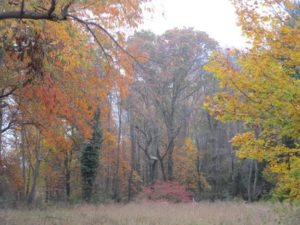
The changing colors between Davidson Mill Park and Pigeon Swamp in South Brunswick, Middlesex County.
DRIVE-BY NATURALIST, RED-TAILED HAWK: As I was returning home from my normal Sunday routine of lunch at the Hightstown Diner in Mercer County, I crossed the Millstone River on the boundary of Cranbury, Middlesex County, and East Windsor, Mercer County. On the Cranbury side, a large bird flew out of the trees, then low along the roadway – a red-tailed hawk, “Buteo jamaicensis.” I cranked off a shot on my camera. Not a good shot, but that is photojournalism – you take what you get, because the news does not necessarily stop for the journalist. The photo, at least, puts in perspective how low the bird was.
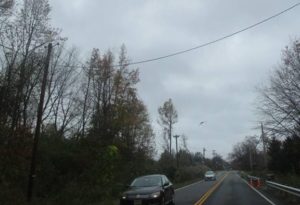
A red-tailed hawk flies low along a roadway on the boundary of Cranbury, Middlesex County, and East Windsor, Mercer County.
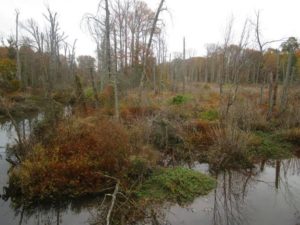
The Millstone River on the boundary of Cranbury, Middlesex County, and East Windsor, Mercer County.
VOICES FROM AFIELD, NO. 3, DEER RUT: I continue seeing normally hidden male deer, “Odocoileus virginianus,” because it is the mating season, or rut. This week, I saw one in southern Monroe, Middlesex County, at night. Then, as I was driving to work one morning in daylight, a deer bolted across a paved road in the Jamesburg Park Conservation Area in the Pine Barrens around Helmetta, Middlesex County. I did not get a good look at the deer, but, based on the way it bolted across the street and because I saw no others, my guess is it was a buck. Paul Migut checked in from South River, Middlesex County: “Spotted buck behind my firehouse. He’s been chasing two does around here.” Again, be careful driving during the rut, which should last until about mid-December.
CLOUDS: This week’s cloud shots are from St. James Cemetery in Monroe, Middlesex County. My family has had a plot there for more than 100 years, since my maternal grandfather, Michael Onda, died in 1917, October.

Clouds over St. James Cemetery in Monroe, Middlesex County.

More clouds from St. James Cemetery in Monroe, Middlesex County.

And more clouds from St. James Cemetery in Monroe, Middlesex County.
VOICES FROM AFIELD, N0. 4, SWIMMING RIVER: Rik van Hemmen, sailor and advocate for the Navesink River watershed, Monmouth County, checked in: “Two weeks ago, just before I hauled my Sea Bright skiff for the winter, we had a perfect tide going up the Swimming River with friends who had never done it before. As is common, it blew their minds to see all this natural beauty.”

Fall on the Swimming River in Monmouth County. (Photograph copyright 2017 by Rik van Hemmen.)
OCEAN TEMPERATURES: Atlantic Ocean temperatures on the New Jersey coast were about 50 degrees to 53 degrees over the November 11-12 weekend.
SUNRISE/SUNSET: For November 12, Sunday, to November 18, Saturday, the sun will rise about 6:40 to 6:45 a.m. and set about 4:35 to 4:40 p.m. For November 19, Sunday, to November 25, Saturday, the sun will rise about 6:50 to 6:55 a.m. and set about 4:35 p.m.
WEATHER: The National Weather Service forecasting station for the area is at http://www.weather.gov/phi/.
IN THE BACKYARD: As I was wrapping up this week’s “Notes from Garden and Afield,” I took a soda break. While in the kitchen, I grabbed four gourds I had on display on the table, opened the back door, stood on the back porch, and threw the gourds across the lawn into the garden. I threw one into a pitch pine, “Pinus rigida,” bordering lawn and garden. A bird must have been in the tree, because a large bird flew out and past me eye-high. Wow! On that note….
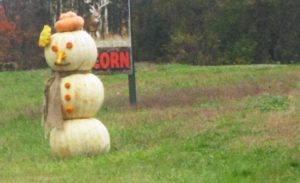
Say, good night, Pumpkin Person. (A pumpkin person at the Red Wagon Farm Market on Route 33, Manalapan, Monmouth County.)
Joe Sapia, 60, is a lifelong resident of Monroe — in South Middlesex County, where his maternal family settled more than 100 years ago. He is a Pine Barrens naturalist and a gardener of organic vegetables and fruit, along with zinnias and roses. He draws inspiration on the Pine Barrens around Helmetta from his mother, Sophie Onda Sapia, who lived her whole life in these Pines, and his Polish-immigrant grandmother, Annie Poznanski Onda. He gardens the same backyard plot as did his Grandma Annie and Italian-American father, Joe Sr. Both are inspirations for his food gardening. Ma inspires his rose gardening. Joe is a semi-retired print journalist of almost 40 years. His work also is at @JosephSapia on Twitter.com, along with Facebook.com on the Jersey Midlands page.
Article and photos by Joe Sapia
Note: The yard references are to my house in the section of Monroe between Helmetta and Jamesburg in South Middlesex County. My yard is in a Pine Barrens outlier on the Inner Coastal Plain, the soil is loamy, and my neighborhood is on the boundary of Gardening Zones 6b (cooler) and 7a (warmer). Notes and photographs are for the period covered, unless otherwise noted.
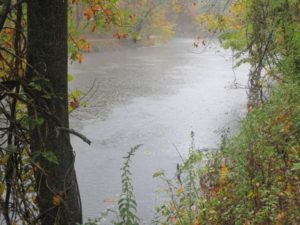
Nor’easter rain pelts the Delaware and Raritan Canal at Kingston, which overlaps the boundary of Franklin, Somerset County, and South Brunswick, Middlesex County. This photograph was taken on the Somerset County side of Route 27.
NOR’EASTER: The Sunday-Monday, October 29-30, nor’easter dropped large amounts of rain throughout the Jersey Midlands. The National Weather Service unofficial high totals from weather stations in the Jersey Midlands portion of seven counties: Hunterdon, up to 4.91 inches in High Bridge; Somerset, up to 4.5 inches in Bernards; Middlesex, up to 3.79 inches in northeast South Brunswick; Monmouth, up to 4.74 inches in West Long Branch; Ocean, up to 5.45 inches in Berkeley; Burlington, up to 4.62 inches in Roebling; and Mercer, up to 5.42 in west Princeton.
The nor’easter also brought reported maximum wind gusts of: Hunterdon, 45 miles per hour at Frenchtown; Middlesex, 52 MPH in the Raritan River/Perth Amboy area; Monmouth, 49 MPH at north Long Branch; Ocean, 58 MPH in the Beach Haven area; Burlington, 47 MPH at Jobstown; and Mercer, 40 MPH at Mercer County Airport.
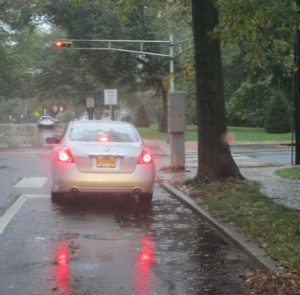
Water pools on a roadway in Princeton, Mercer County, during the nor’easter Sunday, October 29.
NOR’EASTER, BEFORE AND AFTER: Before the Sunday-Monday, October 29-30, nor’easter, all seven Midlands counties had a deficit of rainfall over the last three months. After the nor’easter, only Hunterdon and Mercer have deficits. According to National Weather Service, three-month rainfalls as of Thursday, November 2, were: Hunterdon, 10.7 inches total over the last three months, minus 1.8 inches; Somerset, 12.4 inches, plus .2 inches; Middlesex, 12.0 inches, even; Monmouth, plus .2 inches; Ocean, 12.0 inches, plus .7 inches; Burlington, 11.8 inches, plus .2 inches; and Mercer, 10.2 inches, minus 1.8 inches.
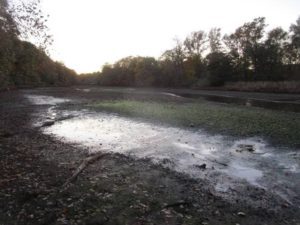
Farrington Lake – here, on the boundary of South Brunswick and East Brunswick looking to North Brunswick, all in Middlesex County – in the days before the Sunday-Monday, October 29-30, nor’easter.
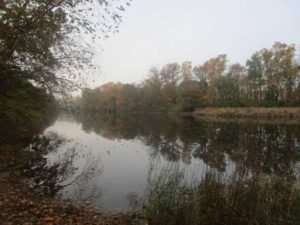
The same view of Farrington Lake in the days after the nor’easter.
FALLEN LEAVES ON ROADWAYS: Motorists, be careful of braking with fallen leaves on the roadway, especially in wet conditions.
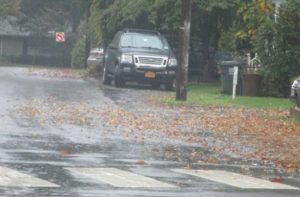
Leaves cover a roadway in the Kingston section of Franklin, Somerset County, during the October 29-30 nor’easter.
FALL FOLIAGE: The fall colors have really brightened, although there is still much green out there and a lot that has already turned color. I am thinking we are in the midst of our (erratic) peak, so enjoy it while it lasts.
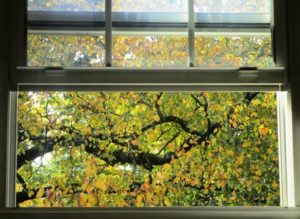
The changing colors of the fall foliage in New Brunswick, Middlesex County, as seen through the window of the Rutgers University Plangere Writing Center.
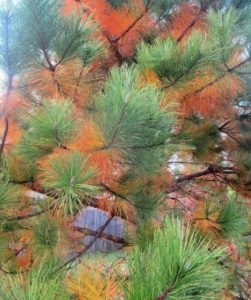
Shattering two myths: One, pine trees are evergreens, but they do shed needles. Here, a pitch pine, “Pinus rigida,” the most common pine of the New Jersey Pine Barrens. This one is in my backyard in Monroe, Middlesex County, but transplanted from the wilds of the Pine Barrens of Monmouth County. Two, the Pine Barrens are not barren. Actually, the Pines are a great place to see the changing colors of the fall, contrasting with the greens of pitch pines and other evergreens.
DEER RUT: As I have mentioned, I am seeing something I do not normally see – adult male deer, “Odocoileus virginianus.” But it is the mating season, or rut, so bucks are moving. On the night of Wednesday, November 1, I saw a buck as I drove through an East Brunswick section of the Jamesburg Park Conservation Area. He trotted into the woods. We appear to still be in the first phase of the rut – bucks following female deer in search of receptive does. The second phase will be mating, the third phase being the rut winding down – the rut lasting until about mid-December. With sex-crazed deer running around, be careful driving.
VOICE FROM AFIELD, JOAN GETAZ ZUMOFF: I still not have seen any “snowbirds,” or juncos, “Junco hyemalis,” at my house in Monroe, Middlesex County. But I expect them any day down for the colder weather from probably as far north as Canada. Actually, they are likely around already and I just have not seen any yet, because Joan Getaz Zumoff checked in just below the Midlands — from Gloucester Township, Camden County, where she had a first sighting Oct. 27. My rule of thumb for snowbirds at my house is around Halloween, October 31. But this has been a wacky year with the weather.
IS IT FALL YET?: Depending on the day, it could be frosty or summer-like. This week, I was shooting photographs at Farrington Lake in Middlesex County. At the part of the lake on the boundary where North Brunswick, East Brunswick, and South Brunswick meet, I am pretty sure I heard a spring peeper treefrog, “Pseudacris crucifer.” The normal time to begin hearing their calls is around early March – that harbinger of spring that sounds like sleigh bells coming from swamps – and, then, they are pretty much done as the spring warms up toward summer.
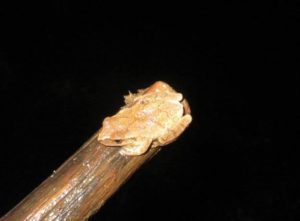
I photographed this spring peeper treefrog in the Manalapan Brook floodplain in Monroe, Middlesex County, in March. They are early spring callers. But I am pretty sure I heard the species calling this week at Farrington Lake on the boundary of North Brunswick, East Brunswick, and South Brunswick, all in Middlesex County – one of those aberrations of nature.
BLOOMING FLOWERS: Garden flowers continued blooming. In Kingston, on the South Brunswick, Middlesex County, side, for example, I saw a beautiful planting of zinnias along Route 27 in front of the Eno Terra restaurant.

Here in Kingston on the South Brunswick, Middlesex County, side of Route 27, grows an ornamental planting of zinnias with the fall foliage colors in the background.
VOICE FROM AFIELD, CHRIS BEVINS: Chris Bevins checked in from Monroe, Middlesex County, where he works for the Utility Department: “I was working on a project this morning and the irrigation pond at the end of England Road on the field had a mated pair of freshwater otters eating fish and frolicking.” I hope to see them, because I have never seen an otter, “Lontra canadensis.”
MY GARDEN: My vegetable garden – between Helmetta and Jamesburg in South Middlesex County — took a licking because of heavy rain over the summer. Other than the colorful and pollinating-attracting zinnias, it was a bad year – basically only a bit of sweet corn to show for the work. But, then this week, I harvested some of my early spring plantings of Lake Valley “Rainbow Blend” carrots. Now, I will watch to see how my late-season planting of carrots does.

Planted April 8 as part of my early crop, these Lake Valley “Rainbow Blend” heirloom carrots were harvested Sunday, October 29.
VOICE FROM THE GARDEN, PAUL MIGUT: Paul Migut, now in his early 60s, who has been gardening since childhood, reported in from South River, Middlesex County: “November 2, a balmy 75f. Garden cleaned out and tilled up. A few eggplants picked and one grape tomato plant still hanging in there. While no match for Pon’s garden from days of old” – a reference to his Uncle Stanley “Pon” Ceslowski and his garden in Monroe, Middlesex County – “my 20 feet by 20 feet section still manages to provide vegetables for the two of us” – Paul and his wife, Karen – “and then some.”

The “last of the eggplants,” according to Paul Migut, from his South River, Middlesex County, garden.
DRIVE-BY NATURALIST, VULTURES: During the nor’easter, I came across these vultures in the Monmouth Junction section of South Brunswick, Middlesex County.
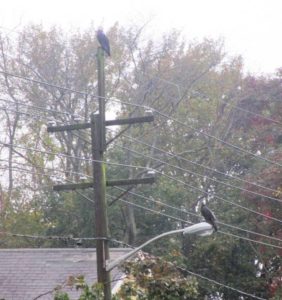
Vultures across the street from the Monmouth Junction Elementary School in South Brunswick, Middlesex County.
DRIVE-BY NATURALIST, HAZY SKY: On Thursday, November 2, I awoke to weather reports warning of fog. By the time I left the house around 8 a.m., though, there was no ground-level fog to speak of, but the sky had a haze. Sunshine fighting through that haze provided a beautiful view – one to photograph.

The sun breaks through the haze over the Jamesburg Park Conservation Area on the boundary of South Brunswick and East Brunswick, both in Middlesex County.
CLOUDS, NEW BRUNSWICK: Beautiful cloud views continue. This week, for example, at New Brunswick, Middlesex County – the Douglass-Cook campus of Rutgers University and along the Raritan River.
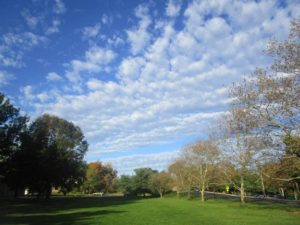
Clouds above the Douglass-Cook campus at Rutgers University in New Brunswick, Middlesex County.

Over the Raritan River from George Street in New Brunswick, Middlesex County.
RUTGERS UNIVERSITY SQUIRRELS: As I walk through the Rutgers University College Avenue and Douglass-Cook campuses in New Brunswick, Middlesex County, Mondays through Fridays, I find the squirrels, “Sciurus carolinensis,” entertaining and numerous. If I were a squirrel in New Brunswick, I probably would pick the garden-y campus, rather than the urban sectors.
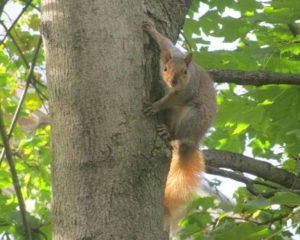
This squirrel has quite a bit of red tint.
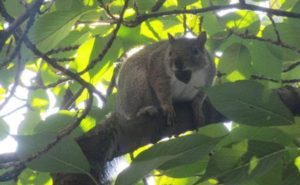
Acting as a squirrel with acorn in mouth.
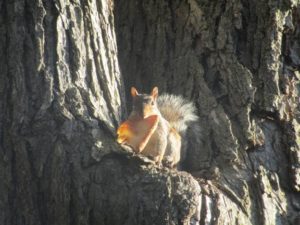
This squirrel was acting like a human, with some kind of bread in its mouth.
OCEAN TEMPERATURES: Atlantic Ocean temperatures on the New Jersey coast were about 60 degrees to 62 degrees over the November 4-5 weekend.
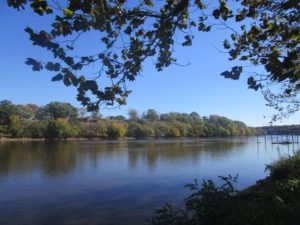
On the banks of the old Raritan River, looking downstream from New Brunswick, across the river to Highland Park, both in Middlesex County.
CHANGE THE CLOCKS: We switch from Daylight Savings Time to Standard Time November 5, Sunday, at 2 a.m., the clocks moving back to 1 a.m.
SUNRISE/SUNSET: For November 5, Sunday, to November 11, Saturday, the sun will rise about 6:35 a.m. set about 4:45 p.m. For November 12, Sunday, to November 18, Saturday, the sun will rise about 6:40 to 6:45 a.m. and set about 4:35 to 4:40 p.m.
WEATHER: The National Weather Service forecasting station for the area is at http://www.weather.gov/phi/.

Pictured is the Full Frost Moon on the November 3-4 overnight. The next full moon is the Long Night Moon on the December 2-3 overnight.
A PARTING NOTE, HAIKU: The Japanese poetry style of 5 syllables, 7 syllables, and, finally, 5 syllables:
Look into the woods –
The leaves are changing colors.
Yellow, orange, red.
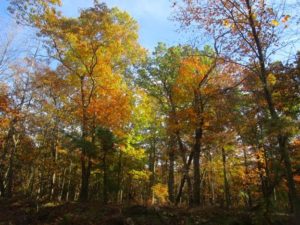
Leaves changing colors in the Pine Barrens around Helmetta, Middlesex County.
Joe Sapia, 60, is a lifelong resident of Monroe — in South Middlesex County, where his maternal family settled more than 100 years ago. He is a Pine Barrens naturalist and a gardener of organic vegetables and fruit, along with zinnias and roses. He draws inspiration on the Pine Barrens around Helmetta from his mother, Sophie Onda Sapia, who lived her whole life in these Pines, and his Polish-immigrant grandmother, Annie Poznanski Onda. He gardens the same backyard plot as did his Grandma Annie and Italian-American father, Joe Sr. Both are inspirations for his food gardening. Ma inspires his rose gardening. Joe’s work also is at @JosephSapia on Twitter.com, along with Facebook.com on the Jersey Midlands page.
Article and photos by Joe Sapia
Note: The yard references are to my house in the section of Monroe between Helmetta and Jamesburg in South Middlesex County. My yard is in a Pine Barrens outlier on the Inner Coastal Plain, the soil is loamy, and my neighborhood is on the boundary of Gardening Zones 6b (cooler) and 7a (warmer). Notes and photographs are for the period covered, unless otherwise noted.
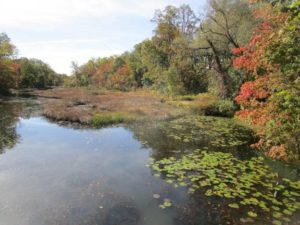
The fall foliage colors on Lawrence Brook in the Deans section of South Brunswick, Middlesex County.
FALL FOLIAGE: The peak of the colors is a little late this year, but this coming week should be very nice for viewing. The combination of fallen leaves and rain can make slippery driving conditions. So, be careful driving.
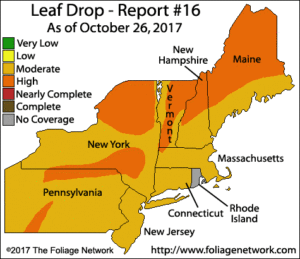
Northeastern United States fall foliage map. (Copyright 2017 by the Foliage Network.)
DEER RUT: Speaking of being careful when driving, look out for deer, “Odocoileus virginianus,” because the rut, or mating season, is on – meaning sex-crazed deer are running around. Normally, bucks stay out of sight, while it is common to see does and their brood. But over the last few weeks, I have noticed movement by bucks. During this week, I have seen a buck along the woods edge at Helmetta and in a driveway in a wooded area of East Brunswick, both in Middlesex County. If dividing the rut into three chapters of one, bucks challenging other bucks and chasing does, two, mating, and three, a wind-down, I would say we are in stage one on the cusp of stage two. The rut will extend to about mid-December.
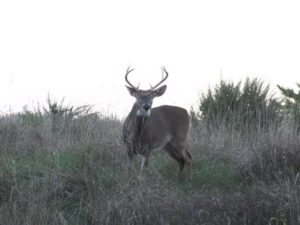
I shot this 7-point buck (with a camera) in 2015, October, just north of the Jersey Midlands near the Metropark railroad station area of Woodbridge, Middlesex County.
WINTER IS COMING: I have been gazing at the constellation Orion, easily identified in the night sky by its belt of three stars. When we can see Orion, it means we are in the colder weather part of the year. And cold weather means being on the lookout for snow. On 2008, October 28, it snowed in the Helmetta area of Middlesex County, but there was little, if any, accumulation. (The average snowfall in the New Brunswick, Middlesex County, area, for example, is 25.8 inches.)
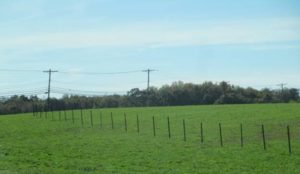
A sign of winter: fencing on farmland to prevent drifting snow. Here on a farm in Upper Freehold, Monmouth County, stakes for snowfencing are in place.
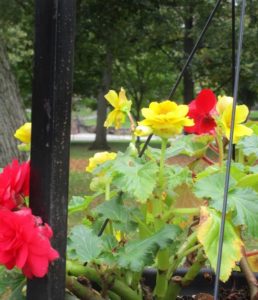
A little bit of lingering warm weather, a little taste of future cold weather — that is this time of year. Here, flowers in bloom on Voorhees Mall at Rutgers University—New Brunswick, Middlesex County.
“SNOWBIRDS”: Has anyone seen the first “snowbird,” or junco, “Junco hyemalis,” of the cold-weather season? I have not noticed any yet, but likely will see one soon, because I normally see the first one of the season around Halloween.
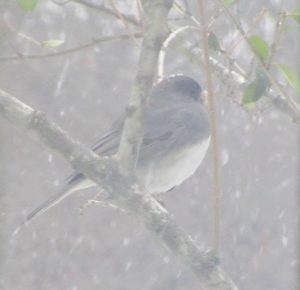
A “snowbird” in my yard in March of this year. They are a cold-weather bird in the Jersey Midlands. Normally, I begin seeing them around Halloween.
BIRD-FEEDING: For the first time in years, I did not feed birds this summer. Although I love zoning out and watching birds at my backyard feeder, I decided to put the birds visiting my yard to work, that is, eating insects – and from my end, saving money on birdseed. But this week, with food gardening pretty much over for the year and cold weather scaring off insects, I resumed feeding. It seemed to take a few days to attract birds to the feeder, but they are now there – blue jay, “Cyanocitta cristata”; chickadee, probably “Poecile carolinensis”; titmouse, “Baeolophus bicolor”; and nuthatch, “Sitta carolinensis.” And I await more species.
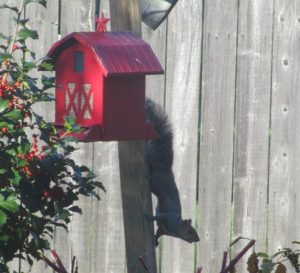
A gray squirrel, “Sciurus carolinensis,” testing the squirrel guard on my backyard birdfeeder. I will have to keep an eye on it to see who wins, feeder or squirrel.
DRY CONDITIONS: All of the Jersey Midlands’s seven counties are below average for rain over the last three months. Through October 27, Friday, Hunterdon received 8.5 inches, down 4.0 inches; Somerset, 9.6 inches, down 2.7 inches; Middlesex, 10.0 inches, down 2.1 inches; Mercer, 7.5 inches, down 4.5 inches; Monmouth, 8.2 inches, down 3.5 inches; Ocean, 9.0 inches, down 2.4 inches; and Burlington, 9.4 inches, down 2.4 inches.

Middlesex County’s Farrington Lake is low. Here, looking from the South Brunswick-East Brunswick boundary across the lake to North Brunswick.
THE WIND: On the morning of Tuesday, October 24, I went to the Helmetta Post Office, where I am third generation with Box 275, to pick up my mail. There, I noticed American flags at the Fire Department and at the historic Avon Inn snapping in the wind. Judging by the flags, the wind was blowing up to 8 to 12 miles per hour. Wind speed can be judged by its impact on flags, trees, and smoke, for example.
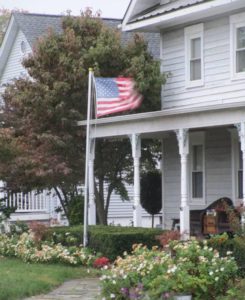
An American flag snaps to the wind at Helmetta’s historic Avon Inn, now a private residence. It dates back as a circa late 1800s-early 1900s inn positioned near a railroad station. (Think of the hotel on the 1963-1970 television sitcom “Petticoat Junction.”)
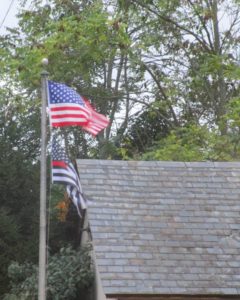
Another American flag in the wind at the Helmetta firehouse and old George W. Helme Snuff Mill pumphouse, which sits on the mill race leading from the former mill to Manalapan Brook.

This is an easy-to-use wind chart from universetoday.com. (Graphic copyright 2017 by universetoday.com.)
CLOUDS OVER NEW BRUNSWICK: During a break from my work in the Plangere Writing Center at Rutgers University’s Murray Hall in New Brunswick, Middlesex County, I looked out a window and noticed the clouds over the Johnson and Johnson pharmaceutical company headquarters along the Raritan River. Again, a beautiful display by Mother Nature:

Clouds over Johnson and Johnson pharmaceuticals headquarters along the Raritan River in New Brunswick, Middlesex County. Photograph from Murray Hall on the Rutgers University downtown campus.
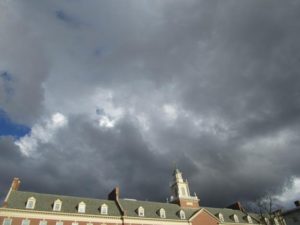
Another photo of clouds over the J&J building in New Brunswick, Middlesex County.
LOST MAN IN THE PINE BARRENS AROUND HELMETTA: A 68-year-old was rescued after becoming lost and weakened during a walk in an East Brunswick, Middlesex County, section of the Jamesburg Park Conservation Area. The man apparently was not physically injured. But he had suffered a stroke about 10 years ago and has physical, cognitive, and speech limitations, according to family friends and officials. Rescuers first had to locate the man. Then, those rescuers were lost and had to be guided out of the woods. A State Police helicopter was called in to light up the woods and find the victim and his rescuers. The helicopter, then, guided them out before it had to leave because it was low on fuel. The rescue took about four hours until about 9:30 p.m. Because of the swampy and woodsy terrain, the man had to be hand-carried out on a stretcher. The Jamesburg Conservation Area, which is owned by Middlesex County Parks and Recreation, is about 1,400 acres of woods, swamp, waterways, and bodies of water, including Helmetta Pond.
HELMETTA POND, GOOD FOR THE SOUL: Ralph “Rusty” Richards, a mentor of mine in the Pine Barrens around Helmetta, Middlesex County, and I were talking at Helmetta Pond when this unfamiliar woman walked by and told us she was going to wet her feet in the Pond. It sure looked good for the soul.
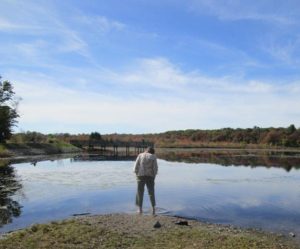
Wading woman at Helmetta Pond.
DRIVE-BY FARM SCENES: In my travels, I photographed various farm scenes in South Brunswick and Monroe, both in Middlesex County, and Upper Freehold, Monmouth County.
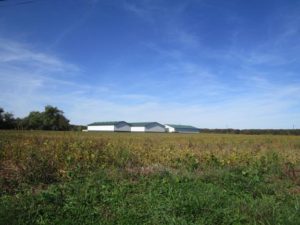
A farm in South Brunswick, Middlesex County.
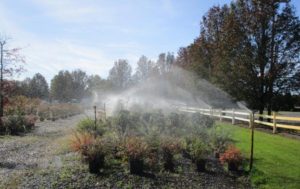
Lark Nurseries in Monroe, Middlesex County.
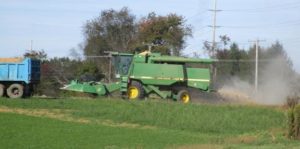
A combine works a field in Upper Freehold, Monmouth County.
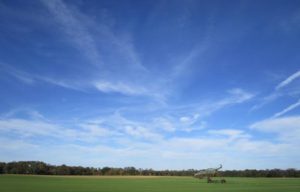
Irrigation equipment on a sod farm in Upper Freehold, Monmouth County.
OCEAN TEMPERATURES: Atlantic Ocean temperatures on the New Jersey coast were about 61 degrees to 64 degrees on the October 28-29 weekend.
CHANGE THE CLOCKS: We switch from Daylight Savings Time to Standard Time November 5, Sunday, at 2 a.m., the clocks moving back to 1 a.m.
SUNRISE/SUNSET: For October 29, Sunday, to November 4, Saturday, the sun will rise about 7:25 to 7:30 a.m. and set about 5:55 p.m. For November 5, Sunday, to November 11, Saturday, the sun will rise about 6:35 a.m. set about 4:45 p.m.
WEATHER: The National Weather Service forecasting station for the area is at http://www.weather.gov/phi/.
THE NIGHT SKY: The next full moon is the Frost Moon on the Friday-Saturday, November 3-4, overnight.
“WAR OF THE WORLDS” BROADCAST: When you look into the night sky, something may be looking back… On 1938, October 30, Mischief Night, the Jersey Midlands were invaded by Martians in Orson Welles and the Mercury Theatre on the Air’s adaptation of H.G. Wells’s “The War of the Worlds.” The broadcast, https://www.youtube.com/watch?v=9q7tN7MhQ4I.
UPCOMING: October 29, Sunday, 1:30 p.m., from Clean Ocean Action: “There will be a commemoration of lives, homes and businesses lost as a result of (2012’s) Superstorm Sandy. There will be a rally followed by brief comments from various elected officials and the major candidates for Governor. Attendees will line the Asbury Park boardwalk from end to end demonstrating the urgent need to address climate change. The call to action will be captured by aerial photography as attendees hold hands across the boardwalk. For more information or to get involved, contact Ed Potosnak, NJ League of Conservation Voters at ed.potosnak@njlcv.org. RSVP today at njlcvef.org/sandy.”

A tree eats a traffic sign in South Brunswick, Middlesex County.
Joe Sapia, 60, is a lifelong resident of Monroe in South Middlesex County. He is a Pine Barrens naturalist and a gardener of organic vegetables and fruit, along with zinnias and roses. He draws inspiration on the Pine Barrens around Helmetta from his mother, Sophie Onda Sapia, who lived her whole life in these Pines, and his Polish-immigrant grandmother, Annie Poznanski Onda. He gardens the same backyard plot as did his Italian-American father, Joe Sr., and Grandma Annie. Both are inspirations for his food gardening. Ma inspires his rose gardening. Joe’s work also is at @JosephSapia on Twitter.com, along with Facebook.com on the Jersey Midlands page.
Except as noted, article and photos by Joe Sapia
Note: The yard references are to my house in the section of Monroe between Helmetta and Jamesburg in South Middlesex County. My yard is in a Pine Barrens outlier on the Inner Coastal Plain, the soil is loamy, and my neighborhood is on the boundary of Gardening Zones 6b (cooler) and 7a (warmer). Notes and photographs are for the period covered, unless otherwise noted.
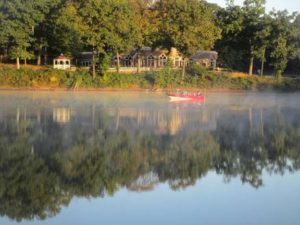
Morning on Farrington Lake, looking from East Brunswick to North Brunswick, both in Middlesex County, at the Hardenburg Lane bridge. Being on New Jersey’s Coastal Plain, where there are few, if any, natural bodies of water, Farrington Lake is created by the damming of Lawrence Brook between Davidson Mill Pond Park and Milltown.
FIRETOWERS: New Jersey’s fall wildfire season coincides with leaves falling and normally runs until about Thanksgiving and that time of year’s colder temperatures. But there could be a wildfire threat at any time if conditions are correct — and, now, we have had both falling leaves and dry conditions. So, the state Forest Fire Service is staffing its lookout towers. Visitors are welcome to go up in the towers when they are staffed – but, remember, you not only have to walk up the tower stairs, but you have to walk down. These Forest Fire Service towers are in the Jersey Midlands: Jamesburg/Middlesex County, Lakewood/Ocean County, Cedar Bridge/Ocean County, Medford/Burlington County, Lebanon/Burlington County, Apple Pie Hill/Burlington County, Batsto/Burlington County, and Bass River/Burlington County.
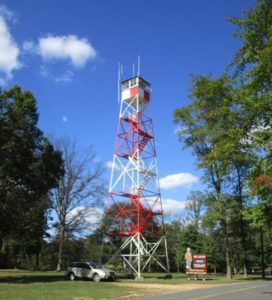
“Jamesburg Tower,” actually outside of Jamesburg in a Monroe Township section of Thompson Park, is about 65-feet-tall, sitting on high ground of about 150 feet above sea level over the Raritan River watershed.
GREAT HORNED OWL: Late at night, as I was at my desk, I thought I heard one of my favorite night sounds, the resonating hoot, hoot, hoot of a great horned owl, “Bubo virginianus.” I went outside and heard what I thought was a faint call of one, then nothing. The great horned is an early breeder, so the calling, signally both territory and looking for mates, should increase. More information, including audio of its calls, is at Cornell University’s All About Birds website, https://www.allaboutbirds.org/guide/Great_Horned_Owl/id.
BALD EAGLE, OCEAN COUNTY: Diane Larson, the home horticulturist and leader of the Master Gardeners program in Rutgers University’s Cooperative Extension Office/Monmouth County, sent in this photograph taken by her stepson, Danny Larson. It is a juvenile bald eagle, photographed on the afternoon of Thursday, October 5, on Beaver Dam Creek in Brick, Ocean County. Diane was leaning toward bald eagle, “Haliaeetus leucocephalus,” but raised a question if it could be a golden eagle, “Aquila chrysaetos.” Two New Jersey Audubon Society naturalists, Pete Bacinski (retired) and Scott Barnes (active) made the identification via this photograph. “It is a juvenile bald eagle,” Pete said. “The bill is too large for (a) golden.” “Yes, definitely a juvenile bald eagle,” Scott said. (Thank you, Danny, Diane, Pete, and Scott, for the team effort.)
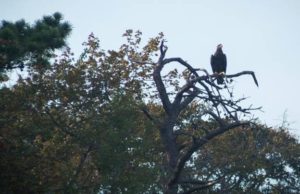
Danny Larson photographed this juvenile bald eagle on Beaver Dam Creek near his family’s house in Brick, Ocean County. (Photography copyright 2017 by Danny Larson.)
DRIVE-BY NATURALIST, DOUBLE-CRESTED CORMORANT: As I drive through the Pigeon Swamp area of South Brunswick, Middlesex County, I pass a warehouse area. There, I often see a double-crested cormorant, “Phalacrocorax auritus,” at a retention pond.

A double-crested cormorant in a retention pond in South Brunswick, Middlesex County.
STEAMING FARRINGTON LAKE: When water temperature is much warmer than air temperature, bodies of water look like steaming soup. I caught this view of Farrington Lake on a cool morning. A few winters back, when we experienced real cold temperatures, this phenomenon was seen at the Atlantic Ocean – a really cool view.
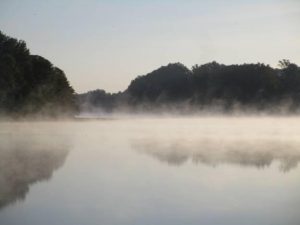
A steamy Farrington Lake, looking from East Brunswick to North Brunswick.
FALL ON THE FARMS: It is fall, so farms are displaying pumpkins and chrysanthemums. Field corn, or feed corn, awaits harvesting.
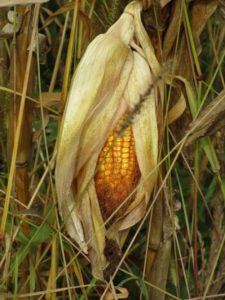
Field corn awaits harvesting in South Brunswick, Middlesex County
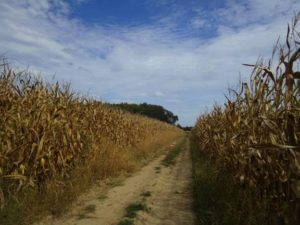
Acres of field corn await harvesting in South Brunswick

Chrysanthemums at Davino’s Nursery in East Windsor, Mercer County.
CLOUDS, NO. 1: One of the week’s beautiful clouds and sky view was from the East Windsor Community Garden in Mercer County.
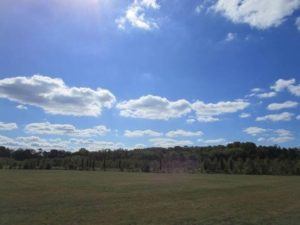
Beautiful clouds and sky view at East Windsor Community Garden in Mercer County.
CLOUDS, NO. 2: Another view of beautiful sky with clouds was from my backyard in Monroe, Middlesex County.

A clouds-in-the-sky view from my backyard in Monroe, Middlesex County.

Another clouds-in-the-sky view from my backyard.
OCEAN TEMPERATURES: Atlantic Ocean temperatures on the New Jersey coast were about 69 degrees to 71 degrees during the weekend of October 7 and 8.
SUNRISE/SUNSET: For October 8, Sunday, to October 14, Saturday, the sun will rise about 7:05 a.m. and set about 6:25 p.m. For October 15, Sunday, to October 21, Saturday, the sun will rise from about 7:10 to 7:15 a.m. and set about 6:10 to 6:15 p.m.
THE NIGHT SKY: The next full moon is the Frost Moon on the November 3-4 overnight.
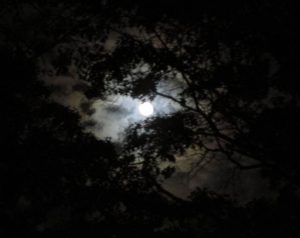
The moon over Manalapan Brook and its floodplain in Monroe, Middlesex County. This moon is waning after October 5’s Full Harvest Moon.
WEATHER: The National Weather Service forecasting station for the area is at http://www.weather.gov/phi/.

A view from Jamesburg Tower, looking south toward Monroe Township High School, from the spring of 2014.
Joe Sapia, 60, is a lifelong Monroe resident. He is a Pine Barrens naturalist and an organic vegetable-fruit gardener. He gardens the same backyard plot as did his Italian-American father, Joe Sr., and his Polish-immigrant, maternal grandmother, Annie Poznanski Onda. Both are inspirations for his food gardening. Joe is active with the Rutgers University Master Gardeners/Middlesex County program. He draws inspiration on the Pine Barrens around Helmetta from his mother, Sophie Onda Sapia, who lived her whole life in these Pines, and his Grandma Annie. Joe’s work also is at @JosephSapia on Twitter.com, along with Facebook.com on the Jersey Midlands page. Copyright 2017 by Joseph Sapia
Article and photos by Joe Mish
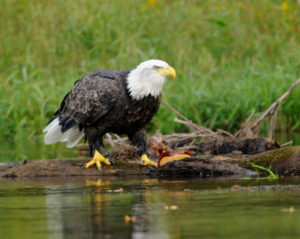
The food chain is not a one way street, as a turtle whose kin may feed on baby ducks, gets picked on by a bald eagle
It is unthinkable to imagine a restaurant where the diners are often listed as menu items. Though when seated at nature’s dinner table, the catch of the day takes on a whole new meaning as predators and prey freely alternate position. The dietary choices are also a surprise as the variety of delectable meals is often at odds with expectations.
Sorting through my library of photos, I was perplexed trying to categorize some images showing two species in close contact. Obviously notable was the reversal of who was eating who.
The first image which prompted these thoughts was captured as I launched my canoe. Here was a very young painted water snake, brilliant colored markings, with a fish sticking out its mouth. Comparing the size of the snake to the fish, I wondered if the snake ‘bit off more than he could chew’, as they say. The fish was wider than the snake and it didn’t look like much progress was being made in the attempt to swallow it. I couldn’t identify the species of fish but thought it a moment of karma as small mouth bass which inhabit the river are well known to forage on anything that swims or crawls in the waters of the south branch. A small snake would hardly be ignored by a hungry bass.
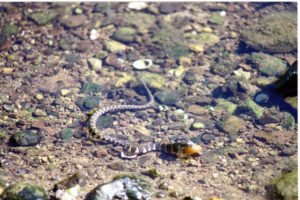
Another image shows a larger painted water snake suspended on o vertical river bank holding onto the tail of a gold colored catfish. As the snake was in an awkward position and didn’t want to go into the water, it was a standoff with the advantage going to the snake. The fish would struggle and then lay still. Eventually the fish broke free. I then remembered a series of images documenting another struggle where a snapping turtle grabbed a painted water snake by the tail. As I paddled along, I saw a water snake swimming across the river and as it neared the opposite bank it suddenly reared up and began to thrash about. Mystery solved as a snapping turtle soon surfaced holding on tight, as the snake now alternated struggling and lying still. As I drifted closer, the turtle was intimidated into releasing its grip and the snake swam off.
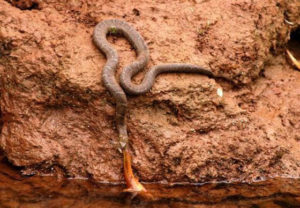
A painted water snake has a catfish by the tail. The snake is barely holding on to the vertical bank , using a tuft of grass to secure its precarious position. the catfish would struggle mighily and then rest. After several tries the catfish appeared dead and lay still for quite some time. Suddenly the catfish came to life and broke free. Again, the scene was captured from a canoe.
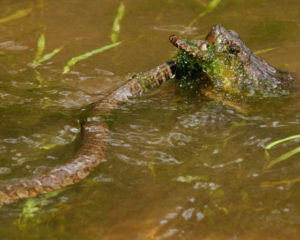
A painted water snakes has the tables turned on it as a snapping turtle reached up to grab the snake swimming across the river.
Turtles are not immune from the proverbial soup bowl as they are prey to many birds and animals that share the same habitat. Even large water snakes will easily swallow a turtle hatchling seeking cover in the water, as will great blue herons, mink, fox, skunk, raccoon and birds of prey.
In a twist of fate, the turtle that killed baby ducks in a farm pond yesterday could very well be on a larger bird’s menu today.
Such was the case when I spotted a bald eagle standing on a log near shore, intently pulling and tearing away at what was probably a deer carcass or white sucker. The eagle would occasionally look up and certainly it saw me from two hundred yards away, apparently not at all intimidated. As I closed the distance, a bright yellow object was clearly visible and the focus of the eagle’s rapt attention. I began to take photos, drifting ever closer and as I started to pass the eagle, it flew off. It was then I realized the eagle was dining on a painted turtle!
Across the land where rivers flow, the lines between predator and prey begin to blur. Don’t be surprised when a squirrel is seen carry a baby crow or a muskrat is swimming underwater holding a baby blue jay or a blue jay is flying off with a dead vole. If you can’t imagine it, it is happening somewhere along our wild rivers.
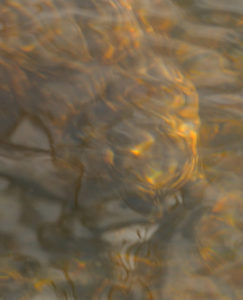
Muskrat with a bluejay swims into its den’s underwater entrance. Mystery for sure.
Author Joe Mish has been running wild in New Jersey since childhood when he found ways to escape his mother’s watchful eyes. He continues to trek the swamps, rivers and thickets seeking to share, with the residents and visitors, all of the state’s natural beauty hidden within full view. To read more of his writing and view more of his gorgeous photographs visit Winter Bear Rising, his wordpress blog. Joe’s series “Nature on the Raritan, Hidden in Plain View” runs monthly as part of the LRWP “Voices of the Watershed” series. Writing and photos used with permission from the author.
Article and photos by Joe Sapia
Note: The yard references are to my house in the section of Monroe between Helmetta and Jamesburg in South Middlesex County. My yard is in a Pine Barrens outlier on the Inner Coastal Plain, the soil is loamy, and my neighborhood is on the boundary of Gardening Zones 6b (cooler) and 7a (warmer). Notes and photographs are for the period covered, unless otherwise noted.

A bit of a strange scene in my backyard: forsythia blooming among the fall foliage changing of colors.
SPRING IN THE FALL: Years ago, I recall seeing sheep laurel, “Kalmia angustifolia,” a spring bloomer, flowering in the fall in the Pine Barrens around Helmetta. Twice this week, I noticed a bird or birds singing away, seemingly a springtime song; And a red-bellied woodpecker, “Melanerpes carolinus,” drummed against my house. Also, this week, I noticed another spring bloomer in flower – forsythia. It flowered in my backyard. I normally see forsythia blooming for the first time of the season in early March to mid-April. What does it all mean? I just think the fall conditions are replicating spring conditions, especially the summerlike temperatures.
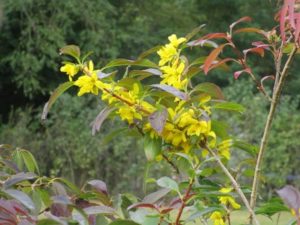
The backyard forsythia in bloom.
THE PINE BARRENS “FALL FOLIAGE” PEAK: The Pine Barrens’s name is a misnomer, neither a place of all pines nor barren lands. And it is a great place to see the changing colors of the fall foliage – the deciduous vegetation changes, with blueberry bushes turning flaming red, and contrasts with the greens of pines, cedars, and laurels. Normally, I look for the fall foliage color peak in the Pine Barrens on October 13 in the wetlands and October 20 in the uplands. This year, that schedule is running behind. The woods around Helmetta are still quite green. (“Fall foliage” is a misnomer, too. In the Pine Barrens around Helmetta, one can observe the changing colors beginning in about mid- to late July.)
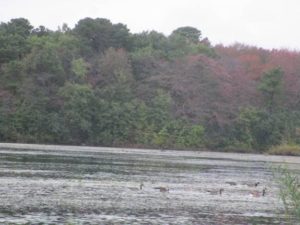
The colors are changing at Helmetta Pond October 13, Friday, but not yet peaking
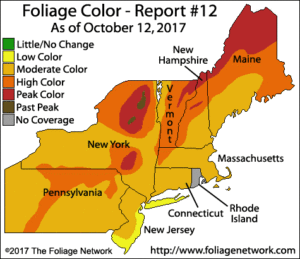
An October 12, Thursday, map from the Fall Foliage Network.
DRIVE-BY NATURALIST, PHEASANT: I just happened to be reading about ring-necked pheasants, “Phasianus colchicus,” the other day. Then, I saw one between the Applegarth and Wyckoff Mills section of Monroe, Middlesex County, the first time I recall seeing one afield in maybe 20 or 25 years. These are non-native – introduced to America from Asia in the 1880s, according to Cornell University’s All About Birds website, allaboutbirds.org. Now, they are naturalized in the United States. This one could have been a naturalized bird or one released for hunting.
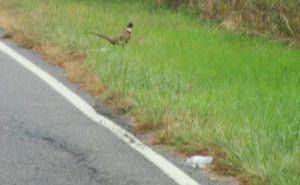
This is a rather blurry photograph, because I came across this ring-necked pheasant unexpectedly while I was driving and had to quickly crank off a photograph before it fled. I am using this photo because it shows a full view of the bird. Also, I did not crop out the roadside litter, to illustrate how wildlife competes with human carelessness.
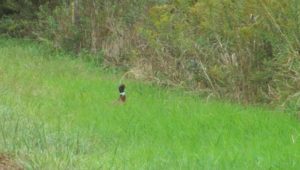
Notice the white, forming the ring around its neck.
CLOUDS: This week’s spectacular cloud scene was in Middlesex County, at North Brunswick, looking toward Milltown. I stopped at the McDonald’s restaurant for breakfast, looked at the sky, and there they were.
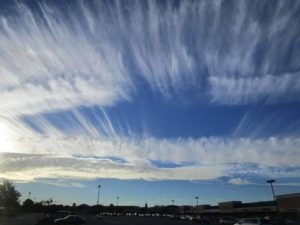
Clouds over North Brunswick, Middlesex County.
VOICES FROM (FAR) AFIELD, JUDY AUER SHAW: Judy Auer Shaw, author of “The Raritan River, Our Landscape, Our Legacy,” checked in from Ohio, reminded by a suggestion in a previous “Garden and Afield” to wear blaze orange in the woods in hunting areas: “I have a story from my teaching years in Michigan. I organized a nature hike for my kids (7th graders) and we all wore browns, grays and greens. As we approached the hiking trail, we were behind a carload of guys wearing orange. It finally dawned on me that we were going out on the first day of hunting season — in complete camouflage. Yikes! Needless to say, we were fine, but I was one worried den mother that day!”

Judy Auer Shaw’s 2014 book.
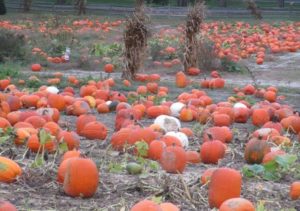
The pumpkin patch at Giamarese Farm on Fresh Ponds Road, East Brunswick, Middlesex County
YARD AND GARDEN: I planted five “false cypress,” or Crippsii,” I picked up at Krygier’s Nursery in South Brunswick, Middlesex County. The Knock Out roses and zinnias continue blooming – the zinnias being visited by such butterflies as the painted lady, “Vanessa virginiensis,” and cabbage white, “Pieris rapae.” Despite blooming, the zinnias are losing their luster, covered with powdery mildew, “Golovinomyces cichoracearum,” and a leaf spot disease. I also found my first raspberry on some bushes planted earlier this year.
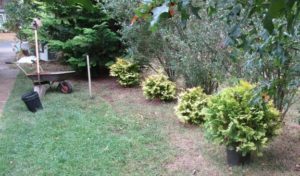
Five “false cypress,” or Crippsii, have been added to my yard.
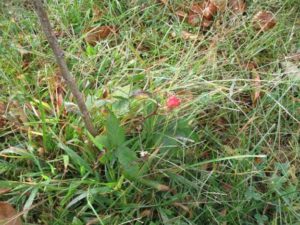
A raspberry fruiting in my backyard garden.
FARMING PERILS IN THE MIDLANDS: I was visiting Krygier’s Nursery, owned by husband and wife Jimmy Krygier, in South Brunswick, Middlesex County, and two perils were obvious – encroaching development and damage caused by browsing deer, “Odocoileus virginianus.” The nursery, a Krygier family business for three generations of about 100 years, is on Route 535, also known as Cranbury-South River Road, Cranbury Road, and South River Road. What was adjoining cornfield up to months ago is now a warehouse property, for example. And one only has to see how the deer have shaped the arbor vitae trees through their browsing. (Krygier’s Nursery is at the corner of Route 535 and Dunham’s Corner Road, South Brunswick, near the Middlesex County Fair Grounds).
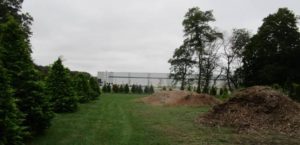
Development encroaches Krygier’s Nursery in South Brunswick, Middlesex County.
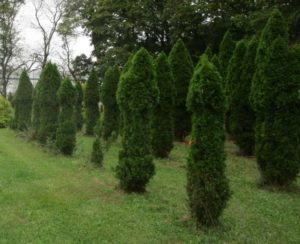
Notice the odd shape to the arbor vitae. It is caused by deer nibbling on the trees.
DEER DOCUMENTARY: “The Deer Stand” is a documentary about deer over-population in the Jersey Midlands. See the movie at https://vimeo.com/233572156.

In fall of 2016, Anna Luiten, an ecologist with the Monmouth County Park System, stands in a Thompson Park forest area over-browsed by deer. The fenced area contains a lush understory, because it is protected from deer.
SNOWBIRDS: Anybody seeing dark-eyed juncos, or “snowbirds,” yet? The birds, “Junco hyemalis,” come down to our area from as far away as Canada during the cold-weather months. I normally begin seeing them in my yard around Halloween. Their color pattern of slate gray on their backs and white on their fronts suggests, “Dark skies above, snow below.”
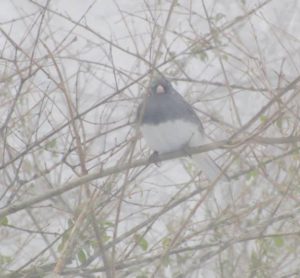
A “snowbird” in the snow in my yard in early 2017.
OCEAN TEMPERATURES: Atlantic Ocean temperatures on the New Jersey coast were about 67 degrees to 69 degrees during the October 14-15 weekend.
SUNRISE/SUNSET: For October 15, Sunday, to October 21, Saturday, the sun will rise from about 7:10 to 7:15 a.m. and set about 6:10 to 6:15 p.m. For October 22, Sunday, to October 28, Saturday, the sun will rise about 7:20 a.m. and set about 6 a.m. to 6:05 a.m. We switch to Daylight Savings Time November 5, Sunday, at 2 a.m., the clocks moving back to 1 a.m.
THE NIGHT SKY: The next full moon is the Frost Moon on the November 3-4 overnight.
WEATHER: The National Weather Service forecasting station for the area is at http://www.weather.gov/phi/.
UPCOMING: 2017, October 28, Saturday, 1 p.m. book signing and 2 p.m. lecture with Marta McDowell, author of “Beatrix Potter’s Gardening Life,” at Jamesburg Presbyterian Church, 175 Gatzmer Ave, Jamesburg. $30 at the door. More information is available from the Earth Center Conservancy (of Middlesex County), www.ecc-nj.com. Beatrix Potter, born in 1866 and died in 1943, was a children’s writer and illustrator. She wrote and illustrated “The Tale of Peter Rabbit,” 1901.

Author Marta McDowell will sign books and speak in Jamesburg, Middlesex County, October 28, Saturday.

Gray squirrels, “Sciurus carolinensis,” appear to be active, burying acorns, preparing for winter. This one was at Rutgers University’s College Avenue Campus in New Brunswick, Middlesex County.
Joe Sapia, 60, is a lifelong Monroe resident. He is a Pine Barrens naturalist and an organic vegetable-fruit gardener. He gardens the same backyard plot as did his Italian-American father, Joe Sr., and his Polish-immigrant, maternal grandmother, Annie Poznanski Onda. Both are inspirations for his food gardening. He draws inspiration on the Pine Barrens around Helmetta from his mother, Sophie Onda Sapia, who lived her whole life in these Pines, and his Grandma Annie. Joe’s work also is at @JosephSapia on Twitter.com, along with Facebook.com on the Jersey Midlands page.
Article by Billy Kurzenberger, Program Coordinator at City of Perth Amboy, Office of Economic and Community Development
The City of Perth Amboy, in partnership with the Rutgers Cooperative Extension Water Resources Program and with funding provided by the New Jersey Department of Environmental Protection (NJDEP), has launched several new projects in its community-based green infrastructure initiative, Perth Amboy SWIM (Stormwater Infrastructure Management).
Washington Park is the site of a new rain garden designed to redirect and absorb rainwater while beautifying the park. The park’s parking lot is now resurfaced in porous pavement designed to allow rain water to pass through the surface and seep into the ground instead of running off into our stormwater sewers.
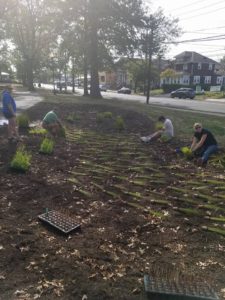
Perth Amboy SWIM rain garden installation, Sept 7/2017. Photo credit: Perth Amboy Mayor Diaz
In addition to the projects at Washington Park, the same partnership is responsible for the installation of two other porous pavement parking lots at municipal parking lot C on Jefferson Street and municipal parking lot RDH on Madison Street. All of these efforts will help us protect our local waterways from nonpoint source pollution, reduce flooding around the City and serve as excellent educational tools for the community.
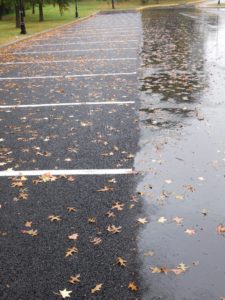
A Perth Amboy SWIM porous/pervious pavement Green Infrastructure project at Washington Park. October 9/2017 was the first rain. Rain water is allowed to pass through the asphalt & soak into the soil rather than flood the neighborhood. Photo Credit: Raritan Riverkeeper.
Perth Amboy SWIM meets on the third Thursday of every month at 10am and always welcomes new members! Meetings are held in the Brighton Avenue Community Center (56 Brighton Avenue, Perth Amboy, NJ). For more information, please contact Billy Kurzenberger at wkurzenberger@perthamboynj.org
Article and photos by Joe Sapia (except as noted)
Note: The yard references are to my house in the section of Monroe between Helmetta and Jamesburg in South Middlesex County. My yard is in a Pine Barrens outlier on the Inner Coastal Plain, the soil is loamy, and my neighborhood is on the boundary of Gardening Zones 6b (cooler) and 7a (warmer). Notes and photographs are for the period covered, unless otherwise noted.
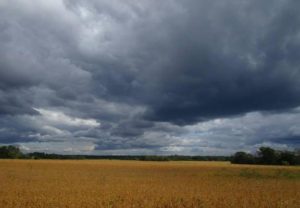
Gray clouds over Monroe farmland, looking toward the Jamesburg Park Conservation Area. Beautiful cloudy skies have presented themselves in recent years over my hometown of Monroe.
FALL HAS ARRIVED: Despite the summer-like temperatures the Jersey Midlands have been experiencing, fall is here. The calendar proclaims the beginning of fall at the September equinox – this year, September 22, when the day’s light and dark are generally equal. However, I regard fall beginning September 1 and running through October and November.
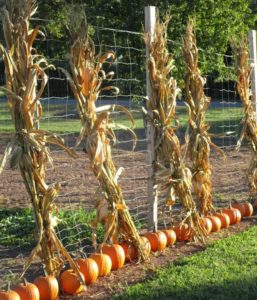
A fall scene at Griggstown Farm in Franklin, Somerset County.
DEER RUT: The mating season, or rut, for deer, “Odocoileus virginianus,” normally peaks from late October to mid-December. Here is Nixle.com-South Brunswick, Middlesex County, advisory:
“The South Brunswick Police Department is reminding motorists to be alert for increased deer activity over the next six weeks. This is typically when we see an increase in car crashes involving deer. The deer can unexpectedly dart onto roads so motorists need to use extra caution. “Motorists are urged to be especially attentive and cautious during morning and evening commutes when visibility may be poor. Deer are involved in thousands of collisions annually in New Jersey, with as many as half coming during the fall mating season, or rutting season…. An adult male deer can weigh 150 pounds or more.
“In the past month there have been a half dozen crashes involving deer in South Brunswick. In past years the majority of crashes have taken place over the next 6 weeks.
“…Deer are most active in the very early morning and around sunset, when visibility conditions can be very difficult. Using caution while driving will become even more important when Daylight Saving Time ends November 6, causing commutes to align with periods when deer are most active. For motorists, low levels of light and sun glare can make it very difficult to see deer that are about to cross the road. Moreover, multiple deer may cross the road at any given moment, usually in a single file.
The following tips can help motorists stay safe during from deer crashes:
-If you see a deer, slow down and pay attention to possible sudden movement. If the deer doesn’t move, don’t go around it. Wait for the deer to pass and the road is clear.
-Pay attention to ‘Deer Crossing’ signs. Slow down when traveling through areas known to have a high concentration of deer so you will have ample time to stop if necessary. If you are traveling after dark, use high beams when there is no oncoming traffic. High beams will be reflected by the eyes of deer on or near roads. If you see one deer, be on guard: others may be in the area. Deer typically move in family groups at this time of year and cross roads single-file. Don’t tailgate. Remember: the driver in front of you might have to stop suddenly to avoid hitting a deer.
-Always wear a seatbelt, as required by law. Drive at a safe and sensible speed, considering weather, available lighting, traffic, curves and other road conditions.
-If a collision appears inevitable, do not swerve to avoid impact. The deer may counter-maneuver suddenly. Brake appropriately, but stay in your lane. Collisions are more likely to become fatal when a driver swerves to avoid a deer and instead collides with oncoming traffic or a fixed structure along the road.
-Report any deer-vehicle collision to a local law enforcement agency immediately.
-Obey the state’s hands-free device law or, better yet, avoid any distractions by refraining from using cellular devices while driving.

I encountered these deer near Rutgers University–Douglass College in New Brunswick, Middlesex County. These are city deer, allowing me to get within 30 or so feet of them.
WEARING BLAZE ORANGE: With the popular deer-hunting season underway, it is probably a good time to wear blaze orange in the woods. Actually, a few years ago, I started wearing blaze orange on my knapsack year-round, because it is hard to keep track of hunting. During the last deer-hunting season, I walked under a tree-stand with a hunter, never seeing him until he spoke to me. Fortunately, I wore blaze orange. (The incident showed me, no matter a life spent in the woods, I let down my awareness.)

My blaze orange vest and one of my blaze orange hats.
BALDFACED HORNET NESTS: As we transition from the warm weather season to the cold, baldface hornets, “Dolichovespula maculate,” will abandon their nests. The abandoned nest is not a threat and may make a folksy bringing-of-the-outdoors-inside ornament. I have two hanging, with another waiting to be hung, in my cellar “cabin” area. Scope your nest now, but wait for colder weather to make sure it is fully abandoned. (Even in season, these nests are not a threat, if far-enough away from human activity. See this Pennsylvania State University Extension factsheet, http://ento.psu.edu/extension/factsheets/baldfaced-hornet.)
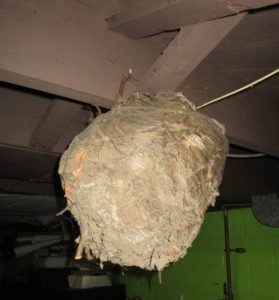
A baldfaced wasp nest on display in my cellar.
MONARCH BUTTERFLIES: Last week, I mentioned monarch butterflies, “Danaus plexippus,” would be heading on their southern migration to either Florida or, more likely, Mexico. The monarchs we see now are a “super generation,” the great-grandchildren of last fall’s migration and these making the complete trip south, if they survive. This week, I was able to photograph one in my garden as it visited the zinnias.
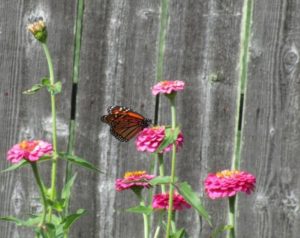
A monarch butterfly on the zinnias in my garden. If all goes right, this butterfly will migrate to at least Florida or, more likely, Mexico. Good luck!
ZINNIAS AND LETTUCE: This week, my zinnias went to Teddy’s luncheonette in Cranbury, Middlesex County, and the Hightstown Diner in Hightstown, Mercer County. The fall lettuce crop in my garden is growing nicely.

The fall lettuce crop in my garden.
GARDEN VOICES: Paul Migut, who gardens in South River, Middlesex County, checked in: “(I) pulled out all Rutgers and yellow tomatoes. (I) still have two grape/cherry tomatoes and two bush beans. And, of course, the ‘surprise’ turnips still growing. Enjoy the Fall season.”

Cherry tomatoes and bush beans from Paul Migut’s garden in South River, Middlesex County. (Photograph copyright 2017 by Paul Migut.)
BEAUTIFUL CLOUDS: The beautiful cloud formations continue. This week, among the places I photographed them was “Jamesburg Lake” (properly “Lake Manalapan”) on the Jamesburg-Monroe boundary, Middlesex County.
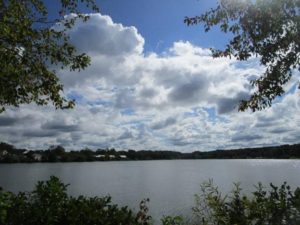
Clouds over “Jamesburg Lake,” Middlesex County.
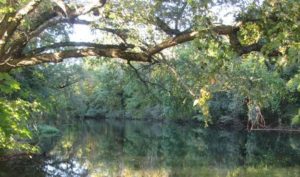
The Delaware and Raritan Canal on the boundary of Rocky Hill and Franklin, Somerset County.
OCEAN TEMPERATURES: Atlantic Ocean temperatures on the New Jersey coast were about 68 degrees to 70 degrees during the weekend of September 30-October 1.
SUNRISE/SUNSET: For October 1, Sunday, to October 7, Saturday, the sun will rise about 6:55 to 7 a.m. and set about 6:30 to 6:40 p.m. For October 8, Sunday, to October 14, Saturday, the sun will rise about 7:05 a.m. and set about 6:25 p.m.
THE NIGHT SKY: The next full moon is the Full Harvest Moon Thursday, October 5.
WEATHER: The National Weather Service forecasting station for the area is at http://www.weather.gov/phi/.
UPCOMING: Another “Rally for the Navesink” meeting is scheduled for Tuesday, October 3, 5:30 p.m., at the Monmouth Boat Club, 31 Union Street, Red Bank. The Rallies are an effort of environmental groups, the community, and municipal, Monmouth County, and state governments to promote improvement of the Navesink River in Monmouth County. The river suffers from high fecal bacteria counts and depleted oxygen levels. More information on the Rally is available from Clean Ocean Action, telephone 732-872-0111, website www.cleanoceanaction.org.
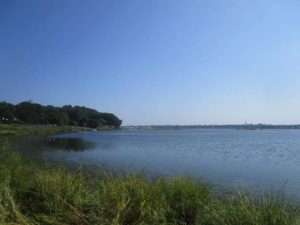
The Navesink River in September, looking downstream from Middletown toward Sea Bright, Monmouth County.

The recent photograph shows Sandy Hook, where the Atlantic Ocean and Raritan Bay meet, from an airplane flight leaving LaGuardia Airport in New York City. Humans, how small we are! (Photograph copyright 2017 by Dan Mulligan, a Long Branch, Monmouth County, kid who, now, lives in Cranbury, where he is on the Township Committee and has served as mayor.)
Joe Sapia, 60, is a lifelong Monroe resident. He is a Pine Barrens naturalist and an organic vegetable-fruit gardener. He gardens the same backyard plot as did his Italian-American father, Joe Sr., and his Polish-immigrant, maternal grandmother, Annie Poznanski Onda. Both are inspirations for his food gardening. Joe is active with the Rutgers University Master Gardeners/Middlesex County program. He draws inspiration on the Pine Barrens around Helmetta from his mother, Sophie Onda Sapia, who lived her whole life in these Pines, and his Grandma Annie. Joe’s work also is at @JosephSapia on Twitter.com, along with Facebook.com on the Jersey Midlands page.
Article and photos by Joe Mish
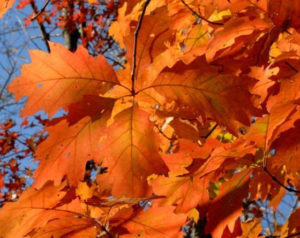
Black oak leaves are ablaze in the most incredible orange color, which makes you wonder how the black oak got its name.
A robe of many colors is October’s alone to wear. It is a coarse cloth, woven with silken threads of yellow and orange, melting into the extreme end of the red spectrum. Set against a clear blue sky, the colors radiate with brilliance. While the sun is otherwise occupied behind gathering clouds, the colors are no less extraordinary, as they hold their sharp contrast, presenting with a soft matte finish.
As the robe is placed upon the earth’s shoulders, the colors slowly flow downward in an infinitely slow progression, best seen from high above the earth. With that image in mind, it is easy to visualize autumn as a living creature leaving a momentary trail of color across the breadth of the tilting earth.
An alternative to a live, time lapsed satellite image of autumn’s gradual crawl across the latitudes, is best seen from a lofty vantage point with expansive views. Though the view is static, the full range of colors is on display. The cloth of the colorful cloak lies tight against the contour of the wooded mountains, each undulating feature of the landscape accentuated by shade and light. On a typical sunlit October day, herds of white billowy clouds drift across the blue sky followed on the ground by their shadows trying to keep up. As the lagging shadows flow across the colorful mountainsides, the tints change for a brief moment to provide a sense of movement to an otherwise still image. The scene is more dramatic if you can imagine the passing shadows being that of the artist’s hand working as you watch.
Retreating from distant views to stand within the October woodlands, individual trees and stands of trees become the focus. Each species resplendent in their own genetically defined color, modified to some degree by soil conditions, specifically, available nutrients and moisture. Instead of looking at a mass of treetops where smudges of varied colors blend together, we now see the pixels that make up the distant image.
Comparing trees of the same species, we can see the individual variation of color. Many trees with yellow leaves such as hickories, Norway maples, cherry and tulip poplar trees are very consistent in color. Oaks, sweetgum and some maples, whose leaves have a red component, show the most diversity.
The most glorious displays of fall color are where we find them, scattered among the local landscape. Each, an emissary heralding the arrival of autumn; apart from the mass of color sweeping across the land.
We all have a perennial favorite we watch on a daily basis to gauge the progress of autumn color.
A lone white oak in the middle of a field or a native red maple pressing against the chain link fence in the backyard, as seen from the bathroom window, serve as daily alerts.
Among the many autumn images accumulated in my experience, the one that keeps appearing is an old abandoned farm road lined with Norway maples, all the same size. The tree tops form a tight canopy over the road, keeping it clear of weeds and paving it with a golden carpet of fallen leaves. The length of the yellow paved road has a hint of a vanishing point that beckons a traveler to follow deeper into the fire of autumn color.
Author Joe Mish has been running wild in New Jersey since childhood when he found ways to escape his mother’s watchful eyes. He continues to trek the swamps, rivers and thickets seeking to share, with the residents and visitors, all of the state’s natural beauty hidden within full view. To read more of his writing and view more of his gorgeous photographs visit Winter Bear Rising, his wordpress blog. Joe’s series “Nature on the Raritan, Hidden in Plain View” runs monthly as part of the LRWP “Voices of the Watershed” series. Writing and photos used with permission from the author.

























































































































